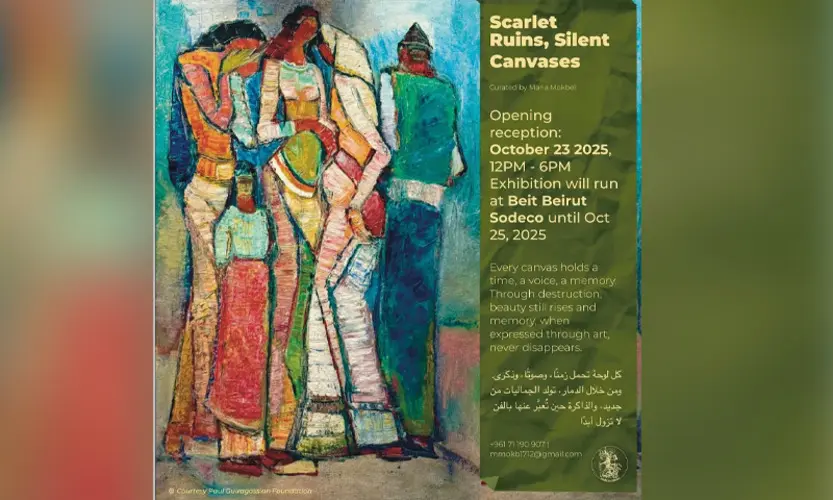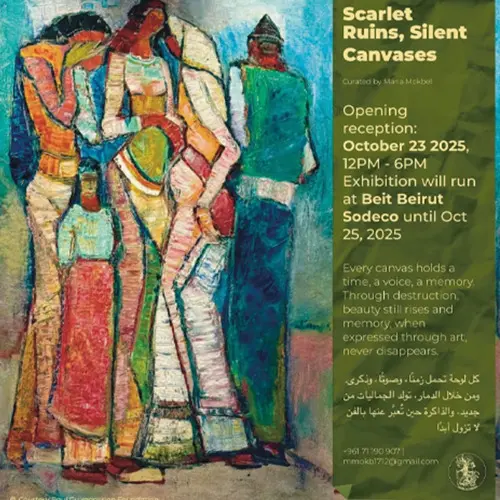No Reviews Yet



DETAILS ABOUT THE EVENT
Scarlet Ruins, Silent Canvases Curated by Maria Mokbel at Beit Beirut - Museum and Urban Cultural Center Curated by Maria Mokbel Scarlet Ruins, Silent Canvases Raised in the heart of the Lebanese art world through my family's collection, I came to see art as a living archive; something that carries memory, identity, and feeling across generations. As a recent graduate of Parsons Paris-The New School, I created Scarlet Ruins, Silent Canvases to reflect what I’ve learned: that art does not just mirror conflict it absorbs it, transforms it, and sometimes bears its wounds. Scarlet Ruins, Silent Canvases explores how conflict in the Middle East has shaped artistic expression. The title itself reflects this duality: Scarlet speaks to blood, urgency, and trauma. Ruins point to destruction and what remains after. Silent Canvases honor the quiet but powerful testimonies that art offers when history is too heavy for words. This exhibition brings together visual narratives revealing the ways artists make sense of instability, memory, and resilience. The selection of works for this exhibition was guided by emotional truth and historical resonance. These artists were chosen not to illustrate war literally, but to explore its imprint on lives, memories, and artistic practice. Their works are not passive documents they are active witnesses. Among them, Ayman Baalbaki’s powerful portraits of veiled figures and destroyed cityscapes embody the duality of resistance and mourning. His brushwork is expressive, charged with emotion, and often confronts viewers with symbols of conflict. Tagreed Darghouth’s haunting skulls echo mortality and aftermath. Her work does not scream it whispers, leaving a lasting emotional weight. Paul Guiragossian’s elongated, abstracted human figures speak deeply to themes of displacement, exile, and collective memory, shaped by his own Armenian-Lebanese background. Meanwhile, Mohamad-Said Baalbaki’s “City Limits” physically damaged in the 2020 Beirut blast stands as object of destruction. These artists, among others, were chosen not only for their aesthetic power but for the urgency their works carry. Their canvases transform pain into form and turn silence into memory. For centuries, Middle Eastern art has been marginalized within the global art narrative, often treated as decorative or “other.” Western museums historically excluded it from the canon, reinforcing stereotypes and erasing nuance. This exhibition is part of an ongoing corrective placing Middle Eastern artists at the center of conversations about global art, identity, and history. It draws on both traditional aesthetics and contemporary experiences, refusing simplification in favor of layered storytelling. This exhibition is for those who lived through war and those who inherited its silence. It invites older generations to revisit memory, not through trauma alone, but through reflection and dignity. It offers younger audiences a way to understand history emotionally not through dates and textbooks, but through images, brushstrokes, and feeling. For international viewers unfamiliar with the Middle East beyond news headlines, this is a space to see the region differently with complexity, depth, and beauty. Curating this exhibition is both professional and deeply personal. I believe that art has the power to preserve, to teach, and to comfort. With this project, I aim to open a space for remembrance, understanding, and cross-cultural dialogue. Scarlet Ruins, Silent Canvases is not only about war. It is about what survives it: stories, culture, and a creative force that refuses to disappear. It asks: how do we carry history forward? How do we look at pain, and still find beauty? Through this exhibition, I hope to offer a space where viewers can feel history, not just see it and where art becomes a bridge between memory and hope. "Every canvas holds a time, a voice, a memory. Through destruction, beauty still rises and memory, when expressed through art, never disappears." Maria Mokbel “Scarlet Ruins, Silent Canvases” An exhibition curated by Maria Mokbel Curatorial statement by Kalim Bechara This exhibition gathers voices from across the Middle East to confront the enduring shadow of war. Each artwork, whether painted, sculpted, photographed, or assembled from fragments of lived experience, speaks as both a testimony and a question: What does it mean to live, create, and dream in the midst of destruction? The Middle East has long been a geography of layered civilizations, yet in recent decades its landscapes have been redrawn by conflict. These works resist the reduction of the region to violence alone; they reveal the intimate realities that statistics cannot capture. The exhibition does not aim to aestheticize suffering, but to honor the depth of human experience under fire. The artists transform trauma into narrative, pain into form, silence into dialogue. Their works embody resilience as much as despair, reconstruction as much as ruin. They remind us that war is not only fought on battlefields but inscribed into memory, culture, and the everyday rhythms of life. As viewers, we are invited into a space of empathy and reflection. These artworks ask us not to look away, but to recognize war’s impact as shared human experience - one that demands both remembrance and responsibility. Why Did I choose ‘Depart’ by Paul Guiragossian as the cover of my exhibition? How do I see the painting, in my point of view? ‘Depart’ is a masterpiece that brilliantly depicts the melancholy of departure and captures the moment when a beginning and an end meet simultaneously. The figure of the man with his back to the viewer appears to fade into the background's blue- green tones, in contrast to the vibrant and sharp colors of the women and their clothing, implying that he is going to leave as the others grieve his absence. What is so remarkable about this composition is that balance is maintained in his presence or absence. If he were removed from the image, no one would notice; instead, the focus would shift from the tall woman in the center to the toddler in red. Départ refers to something far more global. It depicts the experiences of exile, dislocation, and family separation. The picture portrays a universal human condition: the sadness of separation, the strength of those who remain, and the delicate thread of hope that survives each departure. Picasso's Blue Period or Guernica, which tackles human suffering and loneliness, is reminiscent of this masterpiece. If the explanation simply addressed one instance of the Lebanese civil war and ignored other incidents that contributed to a series of regrettable occurrences that ultimately resulted in the war, it would be deceptive to the audience and miss its universal message.

No Reviews Yet